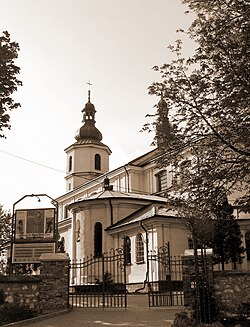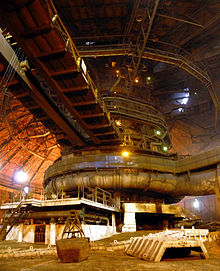Dąbrowa Górnicza
| Dąbrowa Górnicza | ||
|---|---|---|

|
|
|
| Basic data | ||
| State : | Poland | |
| Voivodeship : | Silesia | |
| Powiat : | District-free city | |
| Area : | 188.00 km² | |
| Geographic location : | 50 ° 20 ′ N , 19 ° 11 ′ E | |
| Residents : | 119,800 (Jun. 30, 2019) |
|
| Postal code : | 41-300 to 42-530 | |
| Telephone code : | (+48) 32 | |
| License plate : | SD | |
| Economy and Transport | ||
| Street : | S1 | |
| DK94 | ||
| Rail route : | Zawiercie – Katowice | |
|
Dąbrowa Górnicza – Krakow Tunel – Sosnowiec |
||
| Next international airport : | Katowice | |
| Gmina | ||
| Gminatype: | Borough | |
| Surface: | 188.00 km² | |
| Residents: | 119,800 (Jun. 30, 2019) |
|
| Population density : | 637 inhabitants / km² | |
| Community number ( GUS ): | 2465011 | |
| Administration (as of 2018) | ||
| City President : | Marcin Bazylak | |
| Address: | ul.Graniczna 21 41-300 Dąbrowa Górnicza |
|
| Website : | www.dabrowa-gornicza.pl | |
Dąbrowa Górnicza [ dɔmˈbrɔva gurˈɲiʧa ; ] ( German Dombrowa ) is a city in the Silesian Voivodeship in Poland .
geography
location
Dąbrowa Górnicza is located in the Zagłębie Dąbrowskie (Dombrowa Coal Basin). The city is located around 16 km northeast of Katowice . It is traversed by the Black Przemsa (Czarna Przemsza) and the White Przemsa (Biała Przemsza). Due to its location on the edge of the industrial area, there are many green areas and four artificial lakes, the last of which was opened in 2005, which are used for swimming and water sports. Beavers live in the forests in the east of the city , and the Błędów Desert named after him begins there in the Błędów district , a 32 km² sandy area.
The urban area has an area of 187.81 km², of which 42% is used for agriculture and 22% is forested.
City structure
The city consists of 18 districts ( Dzielnica miasta ): Dąbrowa Górnicza, Błędów, Strzemieszyce Wielkie, Ujejsce, Ząbkowice, Łęka, Łosień, Okradzionów, Trzebiesławy, Kuzki Ławy, Kuzki Łauca, Kuzki Ławy, Kuzki Ławice, Bugzawa ławice, Trzemieszyce Małe, TŁajanzian, Bugzawa, Ratzkazianz, Ratzawazianz, Ratzawazianz, Ratzkazice, Ratzkazkazice, Ratzkazka . However, their limits are only conventional and have not been set by the city administration. The residents also differentiate between individual city quarters (villa districts or prefabricated housing estates) in the city center: Antoniów, Centrum, Dziewiąty, Gołonóg (with residential areas Manhattan, Broadway, Kasprzak), Korzeniec (with the workers' colony and the Zielona city park), Łęknice, Łosień, Mydlice, Piekło, Ratanice, Reden and Trzydziesty. The name of the Reden district goes back to the former Redensgrube, which in turn was named after the mining captain Friedrich Wilhelm von Reden . 1977 to 1984 also Sławków belonged to the urban area of Dąbrowas, since then it has been an independent town again.
history
Until 1945
The first written mention of the place was in 1755. In 1795, with the third division of Poland , the place became part of the new Prussian province of New Silesia . After the defeat of Prussia by Napoleon, the place became part of the Duchy of Warsaw in 1807 , and eight years later it belonged to the Kingdom of Poland . Due to the thick layers of coal in today's city center, industry quickly developed. During this time the first zinc works and the first modern steel works in Poland were built . Its construction was financed by the Polish Bank and contributed to the name Bankhütte (Polish: Huta Bankowa). It was at the time of the People's Republic in Huta im. Renamed Feliksa Dzierżyńskiego . In 1859 Dombrowa was connected to the Warsaw-Vienna railway line . In 1905 there were major strikes by workers in the coal mines around Dombrowa, which ended in a bloodbath. It was not until 1916 that the town received city rights from the Austrian occupiers, but three years later it became the seat of the district. The municipality of Górnicza was attached.
At the time of industrialization in the 19th century, the area to which Dombrowa gave its name belonged to the Russian Congress Poland , Silesia was Prussian and from 1871 part of the German Empire. Even after 1920, the area was part of the Lesser Poland Voivodeship Kielce , while Eastern Upper Silesia formed an autonomous voivodeship . In the time of the Sanacja there were controversial plans to annex the area to the Silesian Voivodeship.
During the attack on Poland in 1939, the small region was occupied by Germans, united with Upper Silesia and, in violation of international law, incorporated into the Third Reich. Dąbrowa came to the district of Bendsburg , the Jews from the region came to a ghetto . (see also: Jewish Cemetery (Dąbrowa Górnicza) )
1945 until today
The city has been part of Poland again since 1945 and becomes a major city after Gołonóg has been incorporated. In the 1970s, the largest steelworks in Poland, Huta Katowice , was built here and is now part of the central concern . In the early 1990s the last coal mine “Paryż” (formerly “Gen. Zawadzki”) closed.
From 1975 to 1998 the city was part of the Katowice Voivodeship .
Culture and sights
Museums
The origins of the Sztygarka Municipal Museum go back to 1889 when a mineralogical collection was established in the mining school. In 1912 it became the Geological Museum. In 1986 the historical collection and the Geological Museum were merged. In 1997 the museum became the property of the city. The museum is located in the so-called Pavilion 1 on the site of the mining school.
theatre
The Palace of Culture ( Pałac Kultury Zagłębia ), opened in 1958, is used as a cinema and theater and event center. The House of Culture ( Dom Kultury ) in Ząbkowice is used for various theatrical and musical performances.
Attractions
The Basilica of Our Lady of the Angels in Dabrowa Górnicza from 1900 and in the district Gołonóg Church of St. Mary and St. Anthony built in 1675. Also, the built in the style of socialist realism district Palace of Culture ( Pałac Kultury Zagłębia ) is one of the interesting buildings of the city as well as the Dom Freja, the former residence of the owners of the watermill Okradzionów and the Kolonia Huty Bankowej (Żeromskiego Street) built in 1918 for employees of the "Huta Bankowa".
Sports
There is an abundance of sports clubs in the city. The MKS Dąbrowa Górnicza with its various departments, especially the women's volleyball and men's basketball teams, should be emphasized .
Economy and Transport
The city's largest employer is Huta Katowice , once the largest steel mill in Poland.
Dąbrowa Górnicza is located on the Warsaw-Vienna Railway ( Warsaw – Katowice railway and Dąbrowa Górnicza Ząbkowice – Kraków railway ) and the Tunel – Sosnowiec railway . Droga ekspresowa S1 and Droga krajowa 94 as well as Droga wojewódzka DW710 and DW910 pass through the city .
In public transport there is a connection to the Upper Silesian tram network .
education
In Dąbrowa Górnicza there are 21 elementary schools , 11 middle schools and 8 high schools of various types, as well as a number of other vocational schools . There is also a municipal library.
politics
City President
At the head of the city administration is a city president who is directly elected by the population. From 2006 to 2018 this was Zbigniew Podraza ( SLD ).
In the 2018 election, Podraza did not run again. The vote brought the following result:
- Marcin Bazylak ( Sojusz Lewicy Demokratycznej / Lewica Razem ) 34.2% of the vote
- Robert Warwas ( Prawo i Sprawiedliwość ) 25.3% of the vote
- Edward Bober (Election Committee “Local Administrative Committee”) 22.8% of the vote
- Katarzyna Zagajska (Election Committee “Together for Dąbrowa Górnicza”) 10.1% of the vote
- Artur Borowicz ( Koalicja Obywatelska ) 7.6% of the vote
In the runoff election, Bazylak prevailed with 61.3% of the votes against the PiS candidate Warwas and became the new mayor.
City council
The city council consists of 25 members and is directly elected. The 2018 city council election led to the following result:
- Sojusz Lewicy Demokratycznej (SLD) / Lewica Razem (Razem) 27.3% of the vote, 9 seats
- Prawo i Sprawiedliwość (PiS) 22.8% of the vote, 6 seats
- Koalicja Obywatelska (KO) 15.2% of the vote, 4 seats
- Election Committee “Local Administrative Committee” 12.8% of the votes, 3 seats
- Election Committee “Together for Dąbrowa Górnicza” 10.4% of the vote, 2 seats
- Election committee “Society of Friends of Dąbrowa Górnicza” 7.9% of the votes, 1 seat
- Kukiz'15 3.7% of the vote, no seat
Town twinning
- Câmpulung Moldovenesc (Romania), since April 2004
- Alchevsk (Ukraine), officially since March 21, 2006
- Studénka (Czech Republic), officially since January 6, 2006
Personalities
sons and daughters of the town
- Karol Adamiecki (1866–1933), economist, engineer
- Zygmunt Różycki (1883–1930), poet
- Bolesław Świętochowski (1895–1975), professor of agricultural engineering
- Aleksander Zawadzki (1899–1964), general and politician
- Michał Spisak (1914–1965), composer
- Boleslaw Tempowski (1921-2008), French football player and coach
- Zdzisław Marchwicki (1927–1977), serial killer
- Wirgiliusz Gryń (1928–1986) actor
- Kazimierz Imieliński (1929-2010), sexologist
- Sobiesław Zasada (* 1930), racing car driver and businessman
- Janusz Gajos (* 1939), actor
- Henning Paur (* 1943), jazz musician
- Leszek Gajdziński (* 1946), discus thrower and Olympic participant
- Jerzy Janikowski (1952–2006), sword fencer and Olympic participant
- Mariusz Kalaga (* 1959), musician
- Dawid Podsiadło (* 1993), singer
- Maja Chwalińska (* 2001), tennis player
Other personalities associated with the city
- Krzysztof Kieślowski (1941–1996), director and screenwriter, lived for a while in the Strzemieszyce Małe district
Trivia
After 1945 the region of Zagłębie and Silesia grew together strongly, thanks in part to a dense transport network. Nevertheless, Polish and not Silesian is spoken in Dąbrowa Górnicza and in the neighboring district towns of Sosnowiec or Będzin. The old antagonisms are revived again and again in the local press, as some Silesians perceive this young region as a foreign body. To this day the adjective Silesian-Dombrowisch is used in relation to the Upper Silesian industrial area. Most Poles do not perceive this distinction and see the district residents as Silesians.
Web links
- Official site of the city (Polish)
- municipal museum "Sztygarka" (Polish)
- Municipal Library (Polish)
- Book of the Jewish Community of Dąbrowa Górnicza and its Destruction (original 696 pages) (English)
- Dąbrowa Górnicza - Historical recordings
- Dabrowa Górnicza - Encyclopaedia of Jewish Communities in Poland, Volume VII (English)
- MKS Dąbrowa Górnicza (Polish)
Individual evidence
- ↑ a b population. Size and Structure by Territorial Division. As of June 30, 2019. Główny Urząd Statystyczny (GUS) (PDF files; 0.99 MiB), accessed December 24, 2019 .
- ↑ Miasto Gmina Powiat Dąbrowa Górnicza on regioset.pl (Polish) as of April 12, 2009
- ↑ Dz.U. 1975 no 17 poz. 92 (Polish) ( Memento from April 8, 2009 on WebCite )
- ^ Result on the website of the election commission, accessed on August 5, 2020.
- ^ Result on the website of the election commission, accessed on August 5, 2020.





